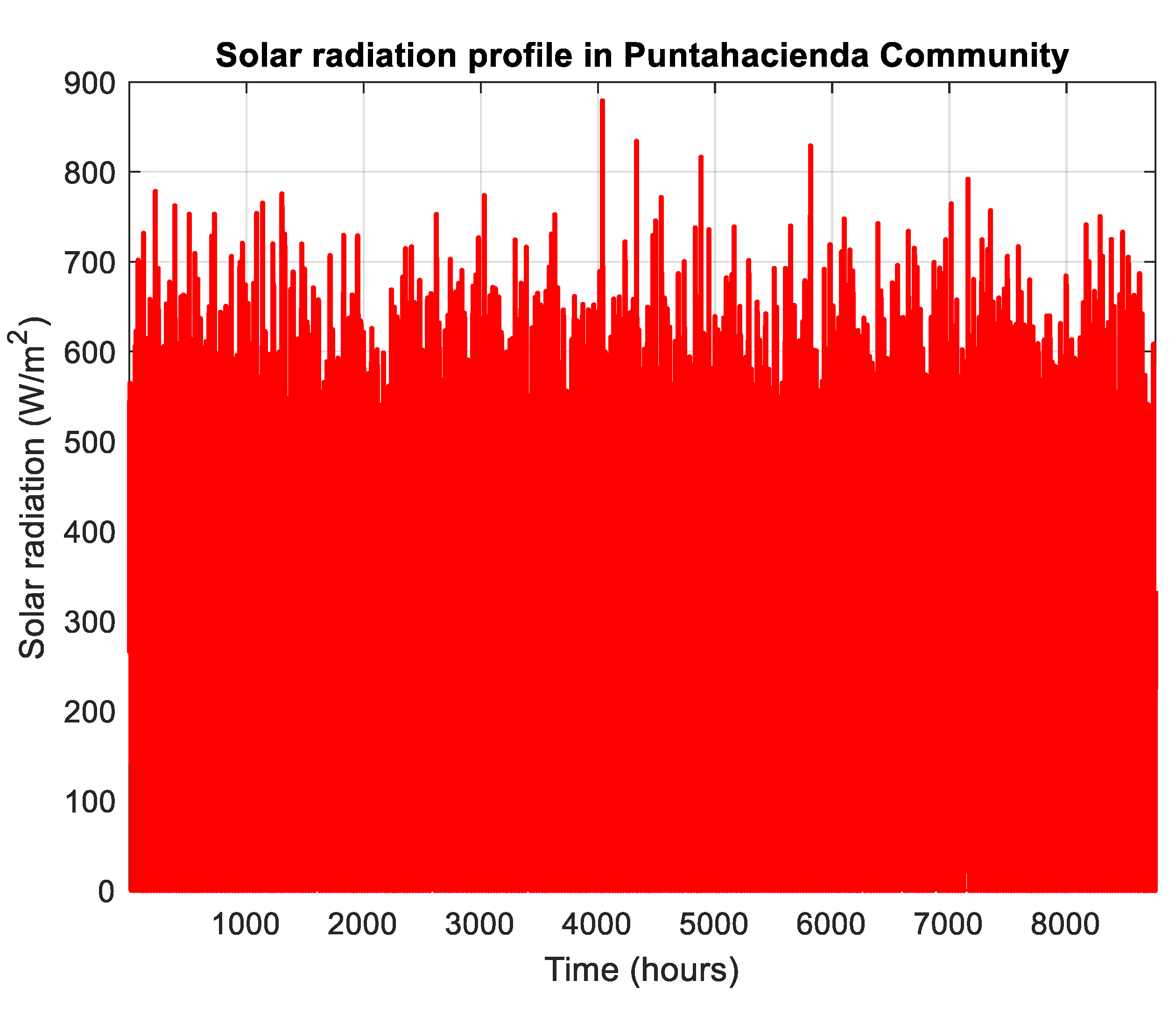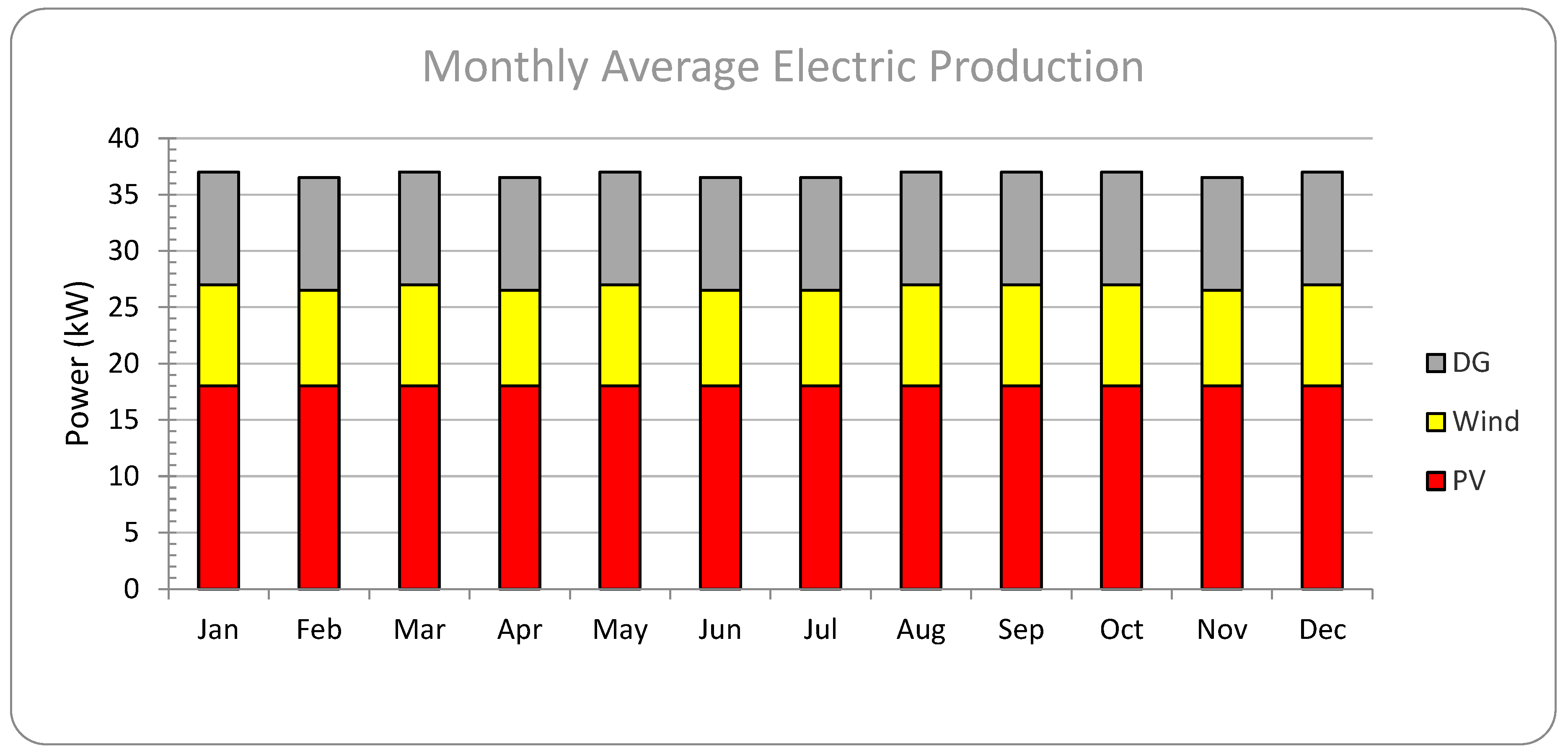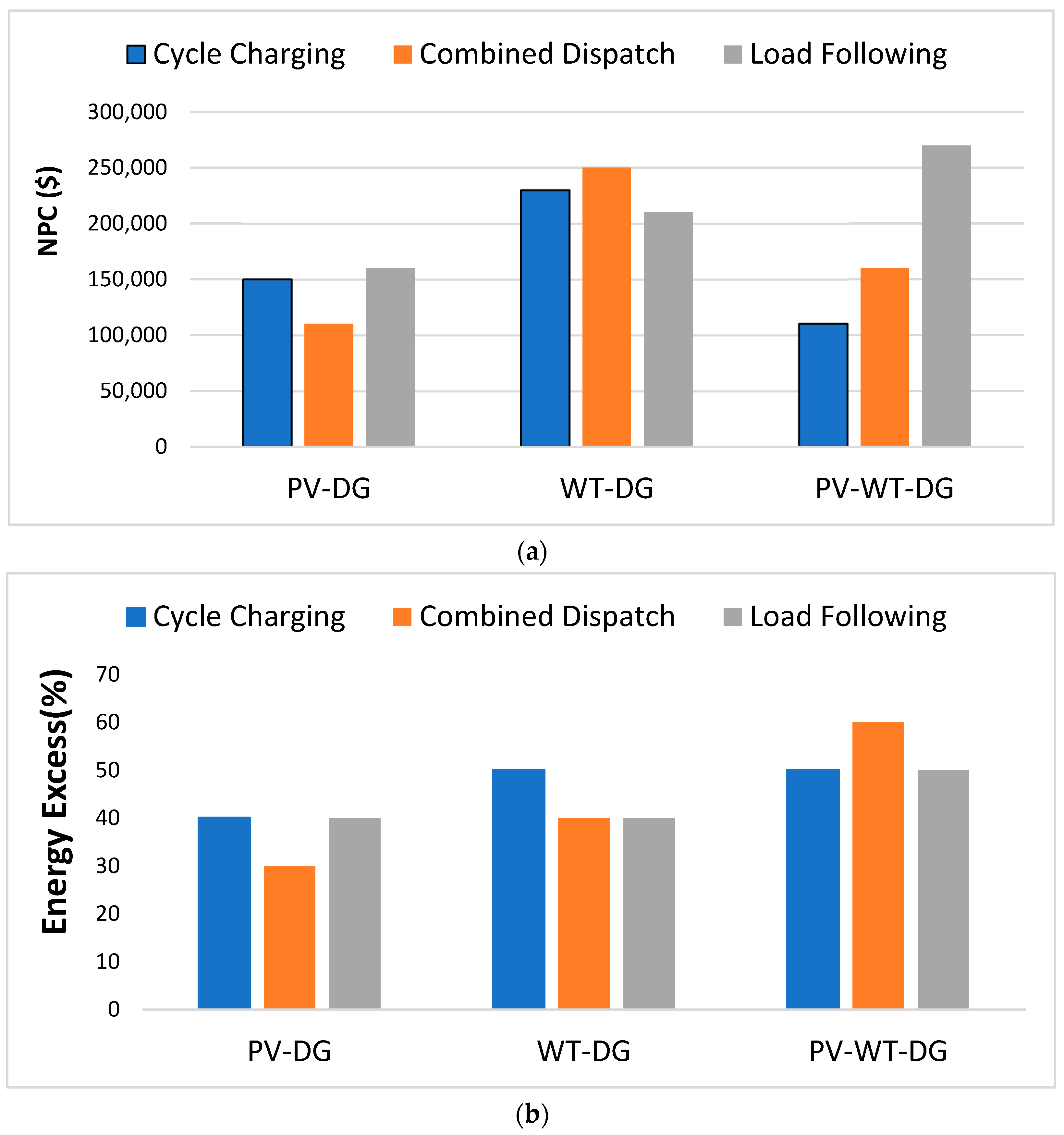The growing global demand for sustainable energy solutions has placed renewable energy technologies at the center of research and development efforts aimed at reducing greenhouse gas emissions and mitigating climate change [
1]. Among the various applications of renewable energy, the integration of electricity systems with water management infrastructure has gained significant importance, especially in remote and rural areas where energy access remains a challenge [
2]. Hybrid groundwater pumping systems powered by renewable sources represent a promising solution to ensure a reliable water supply and reduce dependence on fossil fuels [
3]. However, one of the main challenges facing these systems is the intermittency of renewable resources, particularly solar and wind energy, which can lead to mismatches between energy availability and pumping demand [
4]. In this context, the integration of battery energy storage systems (BESSs) becomes essential, enabling the efficient management of energy flows, supply stabilization, and greater operational flexibility to ensure continuous water pumping even during periods of low generation [
5]. The concept of combining groundwater pumping with battery storage within a renewable energy framework is particularly relevant in regions where water scarcity and energy insecurity coincide [
6]. These systems can offer a dual solution: ensuring access to groundwater for agricultural, industrial, and domestic uses, while simultaneously contributing to the decarbonization of the energy mix [
7]. By using solar photovoltaic panels, wind turbines, or other renewable technologies as the primary energy source, the system reduces its environmental impact and long-term operating costs [
8]. The incorporation of BESSs ensures that excess energy generated during peak renewable energy production can be stored and subsequently used during periods of low availability, such as at night or on cloudy days [
9]. This hybridization not only improves the reliability of water supply systems but also increases their resilience to external impacts such as climate variability, extreme weather events, or power grid disruptions [
10]. Furthermore, the modularity and scalability of hybrid systems make them adaptable to a wide range of contexts, from small rural communities to larger urban infrastructures [
11].
From a technical and economic perspective, hybrid groundwater pumped-storage systems present both opportunities and challenges that require careful evaluation [
12]. Key factors include optimizing system sizing, balancing pumping capacity with storage autonomy, and the cost-effectiveness of different renewable and storage technologies [
13]. Furthermore, the environmental impact of system implementation must be considered, particularly in terms of land use, groundwater sustainability, and battery life cycle emissions [
14]. Recent advances in modeling tools, such as MATLAB/Simulink R2025a [
15] and HOMER V3.16.2 [
16], enable researchers and practitioners to simulate system performance under various scenarios and identify the most efficient configurations. Furthermore, as the costs of solar photovoltaics, wind turbines, and lithium-ion batteries continue to decline, the economic viability of hybrid systems becomes increasingly attractive [
17]. Ultimately, the development and deployment of hybrid groundwater pumping and battery storage systems represent a critical step toward sustainable energy and water management, aligned with global goals such as the United Nations Sustainable Development Goals (SDGs), particularly those related to clean energy (SDG 7) and clean water and sanitation (SDG 6) [
18].
1.1. Context and Motivation
The global transition to renewable energy systems is not only a response to the pressing challenge of climate change, but also an essential strategy for ensuring energy security and sustainable development in the 21st century. In many regions, especially in developing countries and isolated rural communities, access to both clean energy and reliable water resources remains limited, creating a dual challenge that directly impacts food security, economic productivity, and social well-being. Groundwater is one of the most important freshwater reserves, covering almost 50% of global drinking water demand and supporting approximately 40% of agricultural irrigation worldwide. However, conventional groundwater pumping systems are primarily powered by diesel generators or grid electricity, both of which are costly, polluting, and often unreliable in remote environments. Renewable energy sources, such as solar and wind, offer a cleaner alternative but are inherently variable, limiting their independent ability to meet continuous water pumping needs. Therefore, the integration of battery energy storage systems (BESSs) into renewable energy pumping infrastructure offers a promising solution. By bridging the time gap between power generation and demand, these hybrid systems offer a sustainable way to harness renewable energy while ensuring water availability. This context highlights the urgency of rethinking traditional energy and water systems into smart, hybrid configurations that can simultaneously meet human and environmental needs.
The motivation to develop hybrid groundwater pumping and battery storage systems stems from the urgent need to balance the growing demand for water with the imperative to decarbonize energy supply chains. Globally, agriculture alone accounts for approximately 70% of freshwater withdrawals, and a large portion relies on groundwater extraction. At the same time, the water sector consumes a significant portion of energy resources, making the relationship between water and energy a critical area for innovation. Relying on fossil-fuel-based pumped storage systems not only increases greenhouse gas emissions but also exposes communities to fuel price volatility and the logistical challenges associated with transporting fuel. In contrast, renewable energy technologies, when combined with advanced storage systems, can offer cost-effective, resilient, and environmentally friendly alternatives. Furthermore, technological advances in photovoltaic efficiency, wind turbine design, and rapidly decreasing lithium-ion battery costs make hybrid systems increasingly attractive and financially viable. Beyond the technical and economic benefits, implementing these systems also entails significant social and environmental motivations, such as improved access to clean water, reduced pollution, and increased resilience to climate risks. In this way, hybrid groundwater pumping with storage is not just a technological improvement, but a transformative approach that aligns with global sustainability goals and offers tangible benefits to vulnerable communities.
1.2. Review of the Literature
Recent literature on the energy transition shows accelerated and sustained growth in renewables, driven primarily by falling costs for solar photovoltaic and wind power [
19]. Technical and market reports have documented that annual renewable capacity additions have reached record levels in recent years and are projected to continue growing through 2030 [
20]. IRENA documents that by the end of 2023, renewables accounted for approximately 43% of global installed electricity capacity, a milestone that reflects the rapid expansion of clean technologies [
21]. Additionally, analyses such as the Global Electricity Review show that the share of renewables in global electricity generation exceeded 30% for the first time in 2023, with a strong contribution from solar and wind [
22]. These documents and academic reviews underscore that the electrification of sectors (transport, heat) combined with renewables is the most efficient technical path to reducing emissions from the energy system [
23]. Recent scientific publications have also addressed integration challenges—grid stability, flexibility management, and the need for storage—by proposing planning and market frameworks to address them [
24]. The technical literature discusses optimization methods, stochastic modeling, and risk analysis for sizing wind farms, storage, and transmission lines [
25]. The importance of coherent public policies—efficient subsidies, transmission planning, and regulatory frameworks—is also highlighted to accelerate adoption [
26].
Comparative studies across technologies show that in terms of the levelized cost of energy (LCOE), PV and onshore wind are the most competitive options in most regions [
27]. Therefore, the literature recommends prioritizing surface and rooftop PV + wind deployments while reserving biomass, geothermal, and wave as complementary resources when resources and local sustainability allow [
28]. Reviews of real-life cases (community projects and microgrids) indicate that the combination of distributed generation, storage, and demand-side management optimizes resilience [
29]. Academic consensus indicates that the transition is not only technological but also social: local acceptance, technical training, and business models are decisive [
30]. The need to incorporate rigorous environmental assessment is also documented, especially in protected areas, to avoid negative impacts [
31].
The literature on financing highlights instruments such as power purchase agreements (PPAs), blended finance, and multilateral financing to make projects viable at scale [
32]. Finally, recent multilateral agreements (COP28 and the goal of tripling renewable capacity) have strengthened the political and financial basis for accelerating projects through 2030 [
33]. International organizations provide key figures that allow us to gauge the magnitude of the global energy transition [
34]. The IEA estimates an accelerated increase in annual renewable capacity additions, for example, on the order of hundreds of GW per year, with PV and wind accounting for the majority of new installations [
20]. IRENA publishes statistics showing the rapid growth in total capacity: recent figures report thousands of GW installed globally and double-digit annual percentage increases in new capacity [
35]. Tracking reports such as Ember and other think-tanks indicate that renewables reached more than 30% of global electricity generation in 2023, a trend that was predicted to accelerate in 2024 [
36].
These sources also quantify the regional contribution: Asia (China) leads the additions, followed by significant expansion in Europe and the Americas [
21]. At the final consumption level, the IEA projects that the share of renewables in final energy consumption could approach 20% by 2030 under current policy scenarios [
37]. The global statistics underscore that the majority of the increase in renewables is in electricity generation, but there are also advances in biofuels, bioenergy, and the electrification of heat and transport [
38]. In parallel, the data show a growing need for storage capacity and flexibility with batteries, hydrogen, and demand walls to integrate variable generation [
39].
These organizations warn that although capacity is increasing, deployment challenges such as limits on transmission, permitting, and supply chains could slow the pace [
40]. The reports recommend accompanying policies: grid planning, storage incentives, and specialized workforce training [
41]. At the investment level, the reports point to growing flows toward renewables, but also the need for greater public–private investment to close gaps in developing countries [
42].
Several studies have made significant contributions to the field of renewable energy and have been considered as references for this research. Daniel Słyś et al. [
43] conducted a review of the management and optimization of hybrid distributed energy systems, which consisted of a bibliometric mapping of the knowledge and strategies currently employed. The results of the analysis confirmed that local energy system designers are increasingly employing renewable energy systems in their various applications. The analysis also indicated that despite the growing interest in this topic, further development of advanced energy management strategies and optimization methods is necessary to effectively utilize renewable energy sources. Noure Elhouda Choukri et al. [
44] conducted a study at a research center in Morocco that consisted of a techno-economic analysis for the integration of 100% renewable hybrid energy systems. The results obtained show that the scenario involving the combination of photovoltaics, biomass, and batteries offers the optimal solution to meet 100% of energy demand, both from a technical and economic point of view, with a levelized cost of energy (LCOE) of USD 0.33 and a total solar energy share of 83.3%. These results are highly relevant as they offer valuable information on the most suitable technologies and combinations to achieve a 100% green energy supply. Bahar Panbechi et al. [
45] recently conducted another study on hybrid systems in Iran. This study analyzed a model consisting of a hybrid solar–biogas power system and proposed new strategies for sustainable energy development. The baseline model showed that the hybrid biogas–solar power plant could reduce CO
2 emissions by 96.8–97.2% compared to existing natural gas combined-cycle power plants. The most effective approach integrates the optimized scenarios, reduces overall fuel costs, and maximizes revenue potential.
Thavamani Jeyaraj et al. [
46] conducted a stability analysis of hybrid renewable energy systems using future-proof techniques. The findings of their study emphasize the importance of human intelligence and adaptive control systems in improving the stability and overall performance of hybrid systems. The stability of a hybrid system, such as the integration of solar, wind, and thermal collectors, was evaluated. Potential benefits were also presented, including reduced voltage and frequency deviations, shorter payback times, and increased utilization of renewable energy. Laveet Kumar et al. [
47] conducted a comparative analysis of techno-economic research on hybrid energy systems for sustainable energy solutions. These analyses consisted of combinations of photovoltaics (PV) and biomass, with additional components such as an electrolyzer and a fuel cell (FC). The research findings suggest that using a PV/biomass/FC/electrolyzer/battery is a more viable and economical strategy. The estimated increase in LCOE was due to the rising discount rate and fuel prices. Collins N. Nwagu et al. [
48] conducted a study on the integration of solar and wind energy into the electricity grid to improve energy accessibility. This study sought to clarify how solar and wind systems could impact grid resilience, increase electricity accessibility, and define the future direction of sustainable energy. The purpose of this study was to provide an effective tool for the interaction of hybrid solar and wind systems in the changing energy landscape, with the goal of providing communities with reliable access to electricity and promoting a more sustainable future. Guomeng Wei et al. [
49] conducted a techno-economic analysis of a zero-carbon hybrid electricity-hydrogen-water renewable energy system on a remote island. The results indicate that, in addition to meeting electricity demand, the system produced between 14.42 and 17.67 tons of hydrogen or 43.49 tons of syngas and between 5.64 and 13.11 thousand tons of freshwater annually with zero carbon emissions.
In the same town of Puntahacienda, several studies on renewable energy systems have already been conducted. Reference [
50] recently presented a techno-economic analysis of an air-to-water heat pump assisted by a photovoltaic system for the local medical center. The results show that the system could operate normally thanks to the optimal size of the photovoltaic system, which positively impacted the beneficiary population, including medical professionals who work with and care for the elderly and children. Angel Salto [
51] also designed and built a lighting system for a home near the Antonio Neumane School in the Puntahacienda area. The system included a photovoltaic solar system completely isolated from the public power grid. Additionally, lighting systems for a rural road were included. Measurements were taken with a meteorological station, followed by mathematical modeling, simulation in MATLAB Simulink, and sizing of the entire system. Finally, the system that generated electricity for lighting was assembled. Jhonathan Apraez and Cristian Armijos [
52] conducted a groundbreaking study on the construction of monuments powered by solar photovoltaic energy. This study, which was later implemented, sparked interest in the community itself and among other researchers, who expressed interest in identifying the benefits of solar energy for supplying electrical power to decorative lighting systems. The study, conducted by Daniel Icaza and Samuel Sami [
53], included a hybrid renewable energy system. Modeling and simulation were performed to evaluate system stability using MATLAB. The hybrid system was built using solar panels and wind turbines in this same location. The design was ultimately implemented and supplies power to a home in the area. This experience has served as a benchmark for sustainability and is widely accepted and being replicated in other locations with the support of academia. These include the implementation of a renewable energy system in the Macas Alto Chapel [
54] and the lighting system for the façade of the main church of the Quingeo Heritage Center [
55].






















